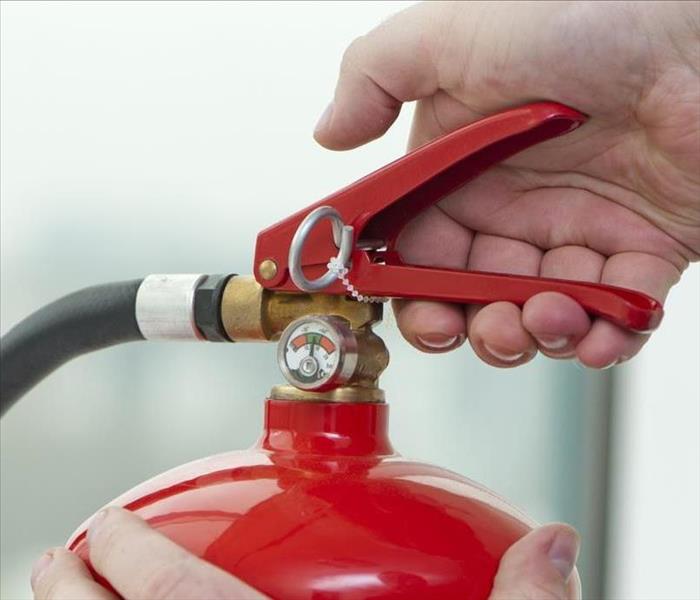Putting a fire out: The PASS Method
8/18/2023 (Permalink)
 The PASS Method is easy to remember and affective.
The PASS Method is easy to remember and affective.
Putting a fire out: The PASS Method
According to the National Fire Protection Association’s Home Structure Fires report more than 26% of reported fires from 2016-2020 occurred in a home and 75% of civilian fire deaths are caused by home fires. Most of these tragic disasters start from cooking, heating equipment, electrical issues, and lighting failures. Being confident and prepared for a home fire can make the difference in life and death. One small but highly effective way to be prepared for a fire is having the proper knowledge of how to put a fire out. The PASS method was created to help simplify the use of a fire extinguisher.
Pull – Maintaining control of the nozzle, pull the pin at the top of the extinguisher.
Aim – Stand back from the flames. With one hand, aim the nozzle at the base of the fire.
Squeeze – Firmly squeeze the nozzle with your hand.
Sweep – Quickly contain the fire by making a sweeping motion with the nozzle.
Now even though a fire extinguisher can be effective it is important to only use it for smaller fires. NEVER take it upon yourself to put out a large fire. If a fire seems too massive and dangerous it is always best to call your local fire department. It is never worth taking the risk when you are one phone call away from having professional help.
After a fire is extinguished and everyone is safe, our SERVPRO of Bay St. Louis/Diamondhead team is ready to help with cleanup and restoration. We have trained and certified technicians that can make the fore “Like it never happened.” Contact our office with more information.
3 Ways to Protect Your Home from Lightning-Related Fires
7/27/2022 (Permalink)
Lightning is hotter than the sun and can reach temperatures of 50,000 degrees Fahrenheit. Lightning-related fires most often occur during the summer storm season, typically months June through August. However, lightning-related fires do happen all year long and in every state. According to NFPA’s latest report “Lightning Fires and Lightning Strikes”, during 2007-2011, U.S. local fire departments responded to an estimated 22,600 fires per year caused by lightning strikes. While this data includes both structure and non-structure fires, nineteen percent of lightning fires were home fires.
As with other natural disasters, there are ways to protect your home from lightning-related fires and mitigate damages.
1- Prevent Lightning-Related Fires by Installing a Whole-house Lightning Protection System
Lightning protection systems work to intercept lightning strikes, provide a conductive path for the electrical discharge to follow, and safely disperse the energy into the ground.
A whole-home lightning protection system consists of:
- Air terminals (a.k.a. lightning rods) mounted on the roof
- Main conductors made of aluminum or copper wires to redirect electricity
- A proper grounding system
- A bonding system to prevent sparks or side flashes
- Surge protective devices
Lightning protection systems should follow the national standards and requirements of the Lightning Protection Institute, National Fire Protection Association, and Underwriters Laboratories. Only experienced and reputable lightning protection contractors listed by Underwriters Laboratories and certified by Lightning Protection Institute should install these systems.
2- Prevent Lightning-Related Fire by Removing Yard Debris
Dry grass, plants, and leaves are highly flammable and should be regularly removed from your yard to prevent a ground fire from spreading to the home.
3- Prevent Lightning-Related Fires by Updating Wiring in Older Homes
Older homes can often experience electrical problems. Consult with a qualified electrician to inspect your home’s electrical and grounding systems. Without a proper grounding system, a lightning strike could cause a fire and affect your home’s electrical foundation.
How to Respond to a Lightning-Related Home Fire
If a lightning strike causes your home to catch on fire, your family’s safety is the top priority. Everyone must exit the home immediately. Once in a safe location far away from your home, call the fire department for help. Do not reenter your home until you are told it is safe.
After the fire is extinguished, limit movement in your home to prevent further damage. Do not try to clean soot or fire damage yourself without proper personal protective equipment. Fire damage cleaning and restoration are best left to trained professionals.
SERVPRO of Bay St. Louis/Diamondhead’s certified and experienced fire restoration professionals are here to help 24-7-365. To learn more about our fire damage restoration services or to schedule an inspection, call our office by dialing 228-467-4450.



 24/7 Emergency Service
24/7 Emergency Service
